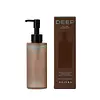What's inside
What's inside
 Key Ingredients
Key Ingredients

No key ingredients
 Benefits
Benefits

 Concerns
Concerns

 Ingredients Side-by-side
Ingredients Side-by-side

Water
Skin ConditioningSodium Cocoyl Glycinate
CleansingGlycerin
HumectantAcrylates Copolymer
Perlite
AbsorbentSodium Chloride
MaskingPhenoxyethanol
PreservativeSodium Hydroxide
BufferingChlorphenesin
AntimicrobialSalicylic Acid
MaskingHydroxypropyl Tetrahydropyrantriol
Skin ConditioningPropylene Glycol
HumectantLavandula Angustifolia Oil
MaskingDisodium EDTA
Linalool
PerfumingButylene Glycol
HumectantCitrus Aurantium Tachibana Peel Extract
HumectantPaeonia Suffruticosa Root Extract
Skin ProtectingCitric Acid
BufferingWater, Sodium Cocoyl Glycinate, Glycerin, Acrylates Copolymer, Perlite, Sodium Chloride, Phenoxyethanol, Sodium Hydroxide, Chlorphenesin, Salicylic Acid, Hydroxypropyl Tetrahydropyrantriol, Propylene Glycol, Lavandula Angustifolia Oil, Disodium EDTA, Linalool, Butylene Glycol, Citrus Aurantium Tachibana Peel Extract, Paeonia Suffruticosa Root Extract, Citric Acid
Ethylhexyl Palmitate
EmollientSorbeth-30 Tetraoleate
EmulsifyingRosmarinus Officinalis Leaf Oil
MaskingLavandula Angustifolia Oil
MaskingEucalyptus Globulus Leaf Extract
PerfumingOlea Europaea Fruit Oil
MaskingVitis Vinifera Seed Oil
EmollientSimmondsia Chinensis Seed Oil
EmollientPrunus Amygdalus Dulcis Oil
Skin ConditioningWater
Skin ConditioningButylene Glycol
HumectantScutellaria Baicalensis Root Extract
AstringentMoringa Oleifera Seed Extract
Skin ConditioningCastanea Sativa Shell Extract
Skin Conditioning1,2-Hexanediol
Skin ConditioningCaprylyl Glycol
EmollientLinalool
PerfumingEthylhexyl Palmitate, Sorbeth-30 Tetraoleate, Rosmarinus Officinalis Leaf Oil, Lavandula Angustifolia Oil, Eucalyptus Globulus Leaf Extract, Olea Europaea Fruit Oil, Vitis Vinifera Seed Oil, Simmondsia Chinensis Seed Oil, Prunus Amygdalus Dulcis Oil, Water, Butylene Glycol, Scutellaria Baicalensis Root Extract, Moringa Oleifera Seed Extract, Castanea Sativa Shell Extract, 1,2-Hexanediol, Caprylyl Glycol, Linalool
Ingredients Explained
These ingredients are found in both products.
Ingredients higher up in an ingredient list are typically present in a larger amount.
Butylene Glycol (or BG) is used within cosmetic products for a few different reasons:
Overall, Butylene Glycol is a safe and well-rounded ingredient that works well with other ingredients.
Though this ingredient works well with most skin types, some people with sensitive skin may experience a reaction such as allergic rashes, closed comedones, or itchiness.
Learn more about Butylene GlycolLavandula Angustifolia Oil is more commonly known as lavender essential oil. It is considered a fragrancing ingredient.
Lavender imparts a famous scent. While the smell is lovely, this ingredient and may sensitize skin in topical products. This is because about 85% of the oil is made up of linalool and linalyl acetate.
When exposed to air, these two compounds become strong allergens. This ingredient exhibits cytotoxicity at low concentrations; amounts of 0.25% have been shown to damage skin cells.
A study from Japan found this ingredient caused lavender sensitivity after widespread exposure.
Lavender essential oil has some antimicrobial, antibacterial, and anti-inflammatory properties. However, the cons of this ingredient may outweight the pros.
More research is needed to confirm lavender essential oil's effects when used in aromatherapy.
Lavandula Angustifolia is known as the English Lavender and famous for creating purple fields in Provence, France.
Learn more about Lavandula Angustifolia OilLinalool is a fragrance and helps add scent to products. It's derived from common plants such as cinnamon, mint, citrus, and lavender.
Like Limonene, this ingredient oxidizes when exposed to air. Oxidized linalool can cause allergies and skin sensitivity.
This ingredient has a scent that is floral, spicy tropical, and citrus-like.
Learn more about LinaloolWater. It's the most common cosmetic ingredient of all. You'll usually see it at the top of ingredient lists, meaning that it makes up the largest part of the product.
So why is it so popular? Water most often acts as a solvent - this means that it helps dissolve other ingredients into the formulation.
You'll also recognize water as that liquid we all need to stay alive. If you see this, drink a glass of water. Stay hydrated!
Learn more about Water